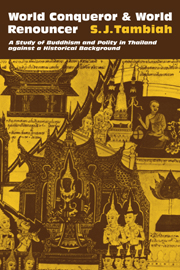 World Conqueror and World Renouncer
World Conqueror and World Renouncer Book contents
- Frontmatter
- Contents
- Acknowledgments
- PART ONE
- 1 Introduction: Reconstructing a Journey
- 2 From Rajadharma (the King's “Whole Duty”) to Dharmaraja (the “Righteous Ruler”)
- 3 The Brahmanical Theory of Society and Kingship
- 4 The Early Buddhist Conception of World Process, Dharma, and Kingship
- 5 Asoka Maurya: The Paradigm
- 6 Thai Kingship and Polity in Historical Perspective
- 7 The Galactic Polity
- 8 The Kingdom of Ayutthaya: Design and Process
- 9 Asokan and Sinhalese Traditions Concerning the Purification of the Sangha
- 10 The Sangha and the Polity: From Ayutthaya to Bangkok
- 11 The Nineteenth-Century Achievements of Religion and Sangha
- 12 The Sangha Acts of 1902, 1941, and 1963
- PART TWO
- Bibliography
- Index
12 - The Sangha Acts of 1902, 1941, and 1963
Published online by Cambridge University Press: 10 November 2010
- Frontmatter
- Contents
- Acknowledgments
- PART ONE
- 1 Introduction: Reconstructing a Journey
- 2 From Rajadharma (the King's “Whole Duty”) to Dharmaraja (the “Righteous Ruler”)
- 3 The Brahmanical Theory of Society and Kingship
- 4 The Early Buddhist Conception of World Process, Dharma, and Kingship
- 5 Asoka Maurya: The Paradigm
- 6 Thai Kingship and Polity in Historical Perspective
- 7 The Galactic Polity
- 8 The Kingdom of Ayutthaya: Design and Process
- 9 Asokan and Sinhalese Traditions Concerning the Purification of the Sangha
- 10 The Sangha and the Polity: From Ayutthaya to Bangkok
- 11 The Nineteenth-Century Achievements of Religion and Sangha
- 12 The Sangha Acts of 1902, 1941, and 1963
- PART TWO
- Bibliography
- Index
Summary
Bishop Pallegoix, whose two-volume Description du Royaume Thai ou Siam was published in 1854, informs us that he had spent 24 years in the kingdom of Siam. It is therefore almost certain that his observations relate primarily to the reign of Rama III (1824–1851). Being a Catholic missionary he may have exaggerated the “laxness” of the Siamese phra; nevertheless, his information on the structure of the sangha and its linkage with kingship is invaluable.
Certain important points emerge from his account, parts of which are quoted below: firstly, that there was a sangha hierarchy, headed by the sangkharat and below whom were the titled abbots of royal monasteries flanked by their assistants and secretaries; secondly, that in fact the authority and powers vested in the sangkharat were circumscribed; next, that it is by contrast the king who was the crucial fountain of authority and source of titles in his position as protector and patron of the religion; and, finally, that the department of ecclesiastical administration (Krom Dharmakara/Thammakan), which we have already identified as being part of the machinery of state administration in the Ayutthayan era, was probably actively functioning around the mid-nineteenth century as an adjudicator of monastic crimes, enforcer of monastic discipline, and as keeper of registers of monasteries and their residents, religious and lay.
- Type
- Chapter
- Information
- World Conqueror and World RenouncerA Study of Buddhism and Polity in Thailand against a Historical Background, pp. 230 - 262Publisher: Cambridge University PressPrint publication year: 1976


